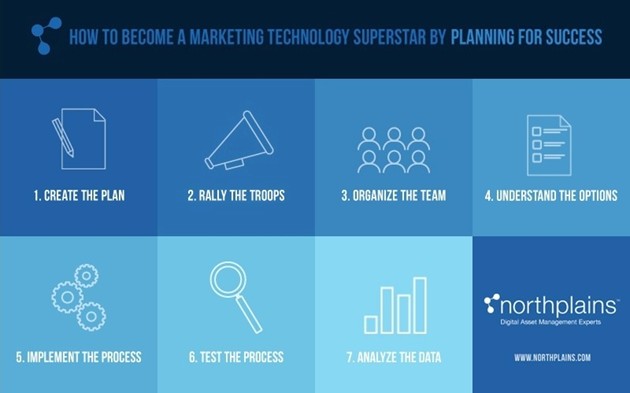Today's successful marketer must stay current on trends, organize digital assets, monitor online conversations, measure ROI, and much more. A well-stocked marketing toolkit is necessary to handle those tasks. And as revenue marketing and content marketing continue to converge, having the right tools and the right people in place is vital.
Keeping up with new technologies and evolving best-practices can be overwhelming; however, to excel, you must drop the fear and tap into those power tools. Here are few to consider:
- Marketing automation allows companies to track prospects through the funnel and tie actions to revenue.
- Social listening helps communications teams monitor their social presence and industry trends online.
- Digital asset management (DAM) software helps marketers better track, manage, and make use of their digital assets.
First, though, be clear about what marketing challenges your organization is facing; only then should you begin to identify and review various technologies.
When you're ready to begin, consider these seven steps for ensuring a smooth marketing technology adoption process:
- Create the plan.
- Rally the troops.
- Organize the team.
- Understand the options.
- Implement the processes.
- Test the processes.
- Analyze the data.
1. Create the plan
Make sure you have clearly identified the problem you're looking to solve and you understand the technology's benefit to your business before you move forward. Ask yourself what you and your team need to accomplish. Where are the gaps in your processes and your reporting? Does your lack of social listening leave you vulnerable? Is there a gap between marketing and sales?
If you look to implement a new process or technology and you can't articulate how it will move the business forward, you'll get shut down fast.
Your plan should also address both the financial and the bandwidth impact of the new technology on the company. Be able to articulate the cost and benefit along with how an increase or decrease in a person's time will affect the business. If the technology will free someone up to take on more projects, clearly articulate how the additional time will be spent. If the new technology requires additional budget, make sure you can demonstrate how you will track and report on the ROI to the business.
If you're lucky enough to be implementing a new marketing technology that will free up budget, be thoughtful about where the additional funds should be spent.
2. Rally the troops
Now that you have your plan in place, identify who the executives or stakeholders are from around the company from whom you will need buy-in. You should present the idea to more than one person to ensure alignment within teams and to reach an agreement on budget allocation.
Think ahead about what the objections will be from your stakeholders, and be prepared with thoughtful answers. Come prepared with successful implementation examples from similar companies and with analyst recommendations or statistics.
Remember in this stage to ask for people's input, listen to it, and make sure they feel heard. People rarely will buy into a new software or process if they feel it's being forced on them. Share your learnings and present your plan, but make sure to leave time for questions and suggestions and consider the perspectives and feedback from everyone on the team.
3. Organize the team
Once you've gotten clearance to implement a new marketing technology, the next step is to identify the team of people who will be directly affected and to organize them around the goals of the new technology. Hopefully you've already been in touch with many of them in the beginning stages, but you'll still want to have a kickoff meeting.
The meeting should be different from an executive buy-in or stakeholder pitch. The people on the team or steering committee will want to know how the technology will make their lives easier or make them better at their jobs. Don't start with a 50-step implementation story, start with the end: What will you be able to achieve together, as a team? How will this new marketing technology be helpful day-in and day-out?
4. Understand the options
Though you may have a clear understanding of how to get from point A (kickoff day) to point B (successful implementation), some people on your team may have other ideas. Don't be a bull in a china shop; be willing to listen to others' concerns, opinions, and ideas.
You have your plan and the path to get there, but don't be so tunnel-visioned that you ignore other options or ways to do things. You might discover a better option or learn something new along the way.
5. Implement the processes
Implementing the technology can sometimes be the easiest part. But now that you've got the tech taken care of, you have to ensure that anyone who interacts with the technology understands the processes and the reasons behind the processes.
Again, people are more likely to buy into something if they feel involved, so take the time to explain the reasons behind the new processes. And, of course, make sure to listen to feedback and be ready to pivot when doing so makes sense.
6. Test the processes
It's not enough to set up the technology or the real-life processes and then sit back and hope they work. The project isn't complete until you've completely tested everything through to failure or success.
There may be things that fall through the cracks or are missed altogether; be prepared to catch them and implement the solution quickly.
All of the work of the team depends on the success of these processes, so make sure to give the testing the time it deserves to ensure the success of your new technology.
7. Analyze the data
The beauty of technology is that it almost always gives you actionable data. Don't just set up the cool new toy and leave it to churn. Make sure you're pulling data and reports; squeeze every last bit of knowledge you can out of it.
Circulate the data in a consumable way to the team, stakeholders, and executives; include a short synopsis of how you plan to react based on the data. That message should be different for each group, but including it reinforces that the team made a smart decision by bringing on a new marketing technology.
* * *
Now that you've successfully implemented and begun using your new marketing technology, make sure to continue to test your processes, try new things, and analyze your data. Hopefully, you'll continue to achieve results and take action based on the data you're able to extract.
And don't drop the ball on communicating your progress: You never know when you'll notice another opportunity where marketing technology can help your team drive the organization forward. You'll want your executives and stakeholders to have confidence in your ability to use your tools successfully, so demonstrate value every step of the way.





